Cell Space System
Cell Protectors
Cell Space Blocks
|
|
|
|---|
Plastic Queen Rearing Bits
There are many types of plastic Queen Rearing Gadgets. Some of them are illustrated here. Other information may be found under Cell Plug Boxes.
|
Cell Space System Cell Protectors Cell Space Blocks |
Plastic Queen Rearing BitsThere are many types of plastic Queen Rearing Gadgets. Some of them are illustrated here. Other information may be found under Cell Plug Boxes. |
|---|
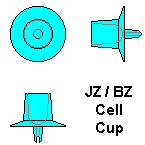 The JZ / BZ cell cup is a useful addition to anyone's queen rearing kit.
The JZ / BZ cell cup is a useful addition to anyone's queen rearing kit.
They Are available in many colours (so that you can colour code the larvae source for record purposes). Or you can use colour to identify batches made on successive days.
Another useful feature is that they can be boiled to clean and sterilise them. However, recent evidence from the Hope Valley queen rearing group suggests that acceptance is highest, of used cups that have only been cleaned by the bees themselves.
The mouth at, 9 mm, is a little wide for my current thinking. However if you can find any that have a strongly saturated colouring dye... They have a smaller radius to the bottom.
|
If you allow virgins to emerge into an incubator or buy them in from another source. They need a release system to stop them being killed. This artificial queen cell can be covered with a strip of foundation to allow controlled release, or see my page on re introduction of instrumentally inseminated queens for another method that is capable of being calibrated for timed release. |
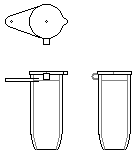
|
|---|
|
Whilst originally designed for holding the Jenter cell cage two part cell plugs, for cell starting and finishing, these plug sets are versatile and can be used for ordinary grafting.
They are particularly useful if fitted in several rows in
the lid of a swarm box
as acceptance can assessed easily and re-grafting performed if
required They can also be used in the Cell Space system by inserting them into specially machined plywood blocks. |
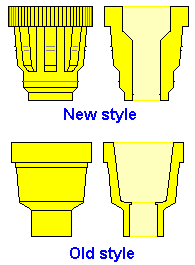
|
|---|
|
They accept the cell cup holders illustrated below or they will take "hair roller" cages for queen banking. They will also accept special cups that will hold "natural" queencells. |
|
|
|
The cell protector device itself is shown at left with a representation at lower right, of it in use, fixed on a nipple using an adaptor.
The narrow end of the cell protector will fit into the mouth of a single ended hair roller cage. In addition to this it will also fit the smaller end of the double ended hair roller cage. |
|
It is show at the same scale as the Nicot item above. |
|
whilst the other type (at left) ledges across two top bars and hangs in the space between them. It can also be jammed between two adjacent comb surfaces. |

|
|---|
|
The device shown at far right does a similar job for the Nicot Cell Cups, as the yellow plugs from the Jenter System.
|

|
|---|
|
The device illustrated right will hold a plug of candy or marshmallow or even a plug of scrunched up paper tissue, and will fit into the single ended hair roller cage or the narrow end of the double ended cage. |

|
|---|
|
The Jenter Cell Plug System has the cell base only on the removable plug. The parts are made by injection moulding from a dark brown plastic material that is not very transparent. The cross section is indicated by the blue portions of the drawings. |

|
|---|
|
The cell is formed by fitting the plug into one of two types of collar. The one illustrated at right, is the old profile which is smaller internally. The mouth is 8.5 mm diameter. |

|
|---|
|
The second type of collar has three "wings" which make it easier to handle. The internal profile is more parallel sided than the smaller version and its mouth is 9.5 mm diameter. I am concerned that this alteration in shape and size is a further manifestation of continuous cellsize enlargement. |
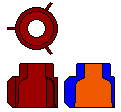
|
|---|
|
The plug and cup (right) form a complete cell unit that then fits into the mouth of either of the yellow plugs illustrated further up the page. |

|
|---|
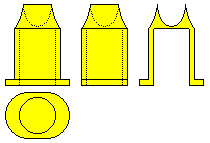
|

|
|---|
The two drawings above show a type of plastic cell cup that mounts into an aluminium channel with a twisting motion. The channels that I have are 320 mm long and 23 mm wide. The cups are available in many colours. I believe that this type originates in New Zealand.
The hair roller types of cage shown below are not exactly to the same scale, the Jenter version being about halfway in size between the two Nicot types. The Jenter version comes with a cap that pushes into one end, the rim at the other end extends inwards about 1 mm so that it latches on to the yellow cup holder.

|

|

|
|---|
Written... Autumn 2000, Revised... 29 January 2002, Revised... 18, 19 January 2003, Upgraded... 15 January 2006,
|